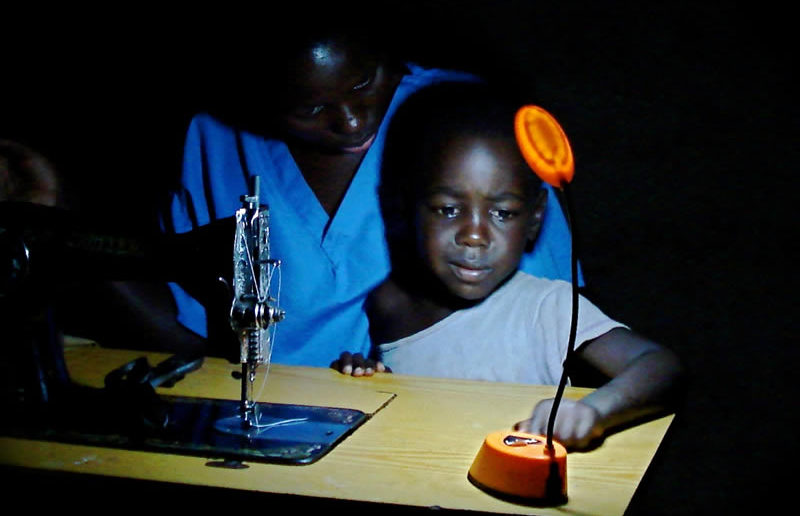
Barefoot Power in action
Maria Njoroge is a young mother living in rural Kenya. She was very happy after giving birth to a healthy baby girl whom she named Naomi, after her grandmother. Maria’s life was not easy as she, like the majority of the people in rural Kenya have no access to electricity. When dusk comes on her grass-thatched hut she has to light a kerosene lamp which is called locally “koroboi”. Less than a month after little Naomi came into the world, while Maria was cooking her meal outside, the koroboi burst, setting the hut ablaze. Naomi died in the inferno.
The problem: energy poverty
Globally, close to two billion people have no access to electricity; they are the so-called BOP (Base Of the social Pyramid). About 40 percent of these people live in Africa. The levels of electrification are lowest in sub-Saharan Africa where less than 10 percent of the general population is connected to the national grid. In rural areas, apart from some dry cell and car battery powered houses, the majority of people still burn kerosene (paraffin) to light their homes when the sun goes down.
The most logical solution to the problem — extending national electricity grids — has proven very challenging in Africa. Despite ambitious plans to increase generation capacity and transmission lines, grid extension is still outpaced by population growth in many places, causing a decrease instead of increase of rural electrification levels.
Two Australian entrepreneurs, Stewart Craine and Harry Andrews, recognized there was an opportunity here. In 2005 they started Barefoot Power, a company aimed at delivering affordable, clean and safe solar based lighting solutions to off-grid areas in low income markets. With all the above mentioned facts in their minds they decided to make Kenya and Uganda focal countries for the dissemination of their solar lamps, called “Firefly”.
Reverse rural electrification
The revolutionary concept behind Barefoot Power was that of “reverse rural electrification”. Instead of building an electricity grid in the traditional way, from a central power plant, through power lines, to an individual household, they recognized the need to start on the other end, inside the homes of the rural people.
Small solar lights replacing dangerous and costly kerosene lamps were the first step towards electrification of rural homes. After small lighting solutions, bigger ones could follow so that, gradually, energy systems would be scaled up. This way, high capital investments in power plants, transmission points and distribution lines would not be required. Scale-up could be done gradually, along with the ability of the end user to pay for it out of his own pocket. A revolutionary approach was born.
Over the past five years, Barefoot Power has proven that its products have met real market demand. Payback on the lighting systems (capital cost versus what people would have spent on kerosene) is typically between three and six months. After the payback period, no daily energy expenses are required for the remaining lifetime of the system.
Startup financing – the challenge of initial investment capital
Initial challenges in setting up a local distribution company were related to a lack of investment and working capital. Finding commercial financing for a startup in Africa was not possible and even the more socially inclined funding institutions could not help out. Besides, the cost of money in Africa is quite high.
Eventually startup capital was raised through the peer-to-peer lending platform. Within two weeks US $15,000 was raised from a total of 107 individual lenders and operations began.
Distribution
During the initial setup of the company, a four day training program was designed with the aim of preparing individual entrepreneurs to sell the Barefoot Power products in rural markets. After the training, the entrepreneurs were to receive 50 percent of their stock on a two week credit plan to reduce their working capital constraints. Upon completion of the training they received the so-called “business in a bag”, a complete package including a branded vest and cap, a receipt book, ID, and a branded bag to carry ten firefly lamps.
Since 2008, Barefoot Power has trained over 300 such entrepreneurs. These individuals have achieved varying levels of success, but overall this way of distribution has been very instrumental in the development of the company by fostering the penetration of the product.
The products – developed for and in cooperation with the BOP customers
The first generation of products, though very basic in design, were immediately recognized by the market as superior alternatives to kerosene lamps. Where an average family would spend around US $6-$8 on kerosene per month, the $18 lamps had a payback time of three months. Given a battery lifetime of about two years, it made good sense to many early day buyers.
As the lights found their way into the rural areas of the country, reports came back about people using the 1Watt solar panel to charge their mobile phones, in addition to the lamps. In Uganda and Kenya geographical mobile coverage is close to 100 percent and ownership of mobile phones is equally high. Nonetheless only 10 percent of the people have access to electricity, forcing many people to charge their phones at expensive charging points in the towns sometimes several kilometers away from their homes.
Barefoot Power decided to change the solar panels from 1 Watt to 1.5.Watt. At 1.5 Watt, most standard mobile phones in the market could be charged, thereby greatly increasing the overall value of the product. The “Firefly12 Mobile”, offering a light, a solar panel and phone charging adaptors for the majority of the phones in the market, was an immediate hit. Despite its 25 percent higher price, it completely replaced the market for the original product. It was an important lesson on how listening to customers can lead to valuable product improvements.
Competition and other challenges
Barefoot Power, having started as one of the early day pioneers in the market, is currently (2012) the market leader in East Africa. With offices in Uganda, Kenya and Rwanda and strong importing and distribution partners in Tanzania, the company anticipates maintaining this position in the region in the years to come.
Competitors like Greenlight Planet, Toughstuff, Dlight, and Trony are all equally young, entrepreneurial businesses, facing similar challenges like financing, steady supply, steady product quality, limited awareness in the market and challenging distribution environments.
Bureaucracy and corruption also pose obstacles. During the first year, the company suffered obstruction from local authorities, especially around importation of products. Complaints about this went as far meeting with the responsible minister and eventually the requests for bribes ended.
Customer service in BOP markets can also be lacking. Living up to a promise of good quality products and customer service is challenging in Africa. Retailers and customers are not yet used to phenomena such as product warranty and an active customer service approach. Barefoot Power has been dedicated to deliver on this promise from the start and continues to expand a customer service infrastructure. The main components of this infrastructure are a network of technical service stations across the country and active enforcement of supplying customers with warranty receipts.
Successes to date
Barefoot Power will have reached around two million Ugandans and Kenyans with affordable, clean and safe lighting and phone charging solutions by the end of 2012. It will have achieved this through a profitable business that directly and indirectly employs over 400 people.
If this technology is adopted by all rural people in the next ten years or so, one can look forward to a brighter future where the little Naomis can celebrate their 15th birthday, study and grow up without exposure of eyes and lungs to toxic fumes.
In order to make this happen, a bumpy road still lies ahead. The implementation of a mass market transformation in the energy sector in rural Africa will need full engagement by and cooperation between players from the public and private sector as well as academia. In parallel to the development of phone networks in Africa, the development of the energy sector will follow a different path than it has in other parts of the world. Centralized, top down energy infrastructure projects will not be abandoned, but will be complemented by bottom up, market driven efforts which will help in speeding up the process of electrifying the un-electrified areas of our planet.
When considering the forces that Barefoot Power is battling in Africa, it is tempting to include other solar lighting companies. But the true enemies this Australian company is fighting are energy poverty, ignorance, poor living standards, bad health, death by fire and loss of property. Barefoot Power is confident that with enough patience and perseverance, this battle can be won for millions of people in Africa.
Izael Pereira Da Silva is an Associate Professor and Director of Centre of Excellence in Renewable Energy and Sustainable Development, CERESD, at Strathmore University in Nairobi, Kenya. Boldewijn Sloet is country director (Kenya) for Smart Solar which is a subsidiary of Barefoot Power.



